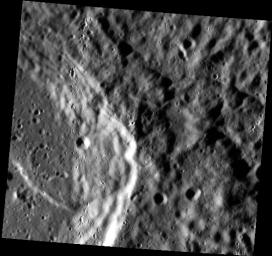
|
Creamed by Clots
- Click the image above for a larger view
- Full-Res JPEG (589 x 555) (51.1 kB)
- Full-Res TIFF (589 x 555) (327.5 kB)
Caption:
The eastern wall of a partially degraded impact crater dominates this image. The Sun is shining from the left (west) and brightly illuminates the steep parts of the wall. Many small craters have formed roughly in a line from the top to the bottom of the scene, about 1/3 of the image width from the left edge. The small craters occur in groups and some of them have an elongated (rather than circular) shape. These characteristics suggest that the small craters are the result of secondary impacts, that is, formed by a rain of ejecta thrown out of a primary impact. The ejecta has struck the surface here in the form of clots and individual chunks of material. Such linear streams of ejecta are responsible for the bright rays visible around fresh impact craters. In fact, this particular ray probably originated at Kuiper crater , which is about 360 km to the north.
This image was acquired as part of MDIS's high-resolution surface morphology base map. The surface morphology base map covers more than 99% of Mercury's surface with an average resolution of 200 meters/pixel. Images acquired for the surface morphology base map typically are obtained at off-vertical Sun angles (i.e., high incidence angles) and have visible shadows so as to reveal clearly the topographic form of geologic features.
Date acquired:
October 27, 2011
Image Mission Elapsed Time (MET):
228199532
Image ID:
937592
Instrument:
Narrow Angle Camera (NAC) of the Mercury Dual Imaging System (MDIS)
Center Latitude:
-19.39°
Center Longitude:
330.4° E
Resolution:
116 meters/pixel
Scale:
The image is about 62 km (38 mi.) wide.
Incidence Angle:
78.4°
Emission Angle:
20.3°
Phase Angle:
98.7°
Background Info:
The MESSENGER spacecraft is the first ever to orbit the planet Mercury, and the spacecraft's seven scientific instruments and radio science investigation are unraveling the history and evolution of the Solar System's innermost planet. Visit the Why Mercury? section of this website to learn more about the key science questions that the MESSENGER mission is addressing. During the one-year primary mission, MDIS acquired 88,746 images and extensive other data sets. MESSENGER is now in a year-long extended mission, during which plans call for the acquisition of more than 80,000 additional images to support MESSENGER's science goals.
These images are from MESSENGER, a NASA Discovery mission to conduct the first orbital study of the innermost planet, Mercury. For information regarding the use of images, see the MESSENGER image use policy .
Cataloging Keywords:
| Name | Value | Additional Values |
|---|---|---|
| Target | Mercury | |
| System | ||
| Target Type | Planet | |
| Mission | MESSENGER | |
| Instrument Host | MESSENGER | |
| Host Type | Orbiter | |
| Instrument | Mercury Dual Imaging System (MDIS) | |
| Detector | Narrow Angle Camera (NAC) | |
| Extra Keywords | Crater, Grayscale, Impact, Map, Radio, Shadow | |
| Acquisition Date | ||
| Release Date | 2012-05-18 | |
| Date in Caption | 2011-10-27 | |
| Image Credit | NASA/Johns Hopkins University Applied Physics Laboratory/Carnegie Institution of Washington | |
| Source | photojournal.jpl.nasa.gov/catalog/PIA15767 | |
| Identifier | PIA15767 | |
